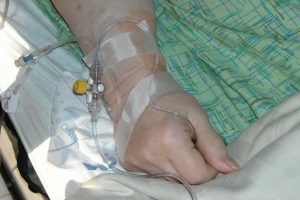Addition of dedicated nursing team to help with catheter insertions can help reduce bloodstream infections in hospitals


A new report published today in the American Journal of Infection Control (AJIC) demonstrates that implementing a dedicated team of nurses to assist with central line insertions can reduce patients’ risk of developing bloodstream infections due to those central lines.
In this report, infection preventionists at UNC Health found that having this dedicated team reduced the proportion of central line-associated bloodstream infections occurring within seven days of line placement by 47% among patients included in this program.
Central lines, or central venous access devices, are alternatives to standard IV lines used for hospitalized patients who are critically ill or need long-term treatment. They are more invasive than IV lines and are associated with an increased risk of bloodstream infections; in the U.S., more than 28,000 deaths annually are attributed to such infections. Clinical guidelines offer specific protocols for ensuring proper insertion of a central line, but an internal study of UNC Health providers found that more than 80% of insertions did not follow all recommended practices.
At UNC Health in Chapel Hill, N.C., infection preventionists and hospital leadership aimed to improve patient outcomes by establishing a specialized nursing team dedicated to assisting with central line insertions. The team was tasked with confirming compliance with a clinical checklist, observing and enabling infection-prevention techniques, and ensuring the availability of needed supplies for the procedure.
To measure results, they focused on bloodstream infections occurring within one week of line placement, as this is the time frame in which infections are most likely to be related to the insertion process. In the first three years of the program, the proportion of bloodstream infections associated with central lines in this one-week time frame decreased by 47% among patients whose line insertions were supported by the specialized nursing team.
“While previous studies demonstrated the effectiveness of having dedicated teams to perform central line insertions, there was surprisingly little information available about the use of specialized support teams for this important procedure,” said Shelley Summerlin-Long, MPH, MSW, BSN, RN, senior quality improvement leader in the Department of Infection Prevention at UNC Health and the lead author of this study.
“We were eager to evaluate whether having a dedicated nursing team to observe and assist would make a difference in patient outcomes in our hospital. The decrease of related infections by 47% during the team’s first three years is remarkable and offers clear validation of this approach.”
The UNC Health study was conducted between February 2019 and March 2022. The specialized team of 4.5 full-time nurses provided round-the-clock support for central lines inserted at the bedside of adult inpatients.
Results show:
- After a ramp-up period in the first year of the initiative, the nursing team routinely assisted with 110 to 120 central line insertions per month in the second and third years of the program.
- When the program began, an average of 60 central lines were placed each month without an assistance request for the specialized team. By the third year of the program, that number had decreased to 44 insertions per month.
- During the three-year period, the overall proportion of central line-associated bloodstream infections remained stable at the hospital. Within that, the proportion of such infections among patients whose insertions were assisted by the nursing team decreased from 19% before program implementation to 10% in year three, for an overall reduction of 47%.
- The team also conducted audits of more than 100 central lines each month and offered coaching to frontline staff in 90% of cases.
“Decreasing central line-associated bloodstream infections improves the quality of care and saves lives,” said Patricia Jackson, RN, BSN, MA, CIC, FAPIC, 2023 APIC president. “The innovative approach described in this study shows that adding trained observers to assist with the placement of central lines has tremendous potential to reduce infections and prevent harm.”
More information:
A Helping Hand: The Impact of a Central Line Insertion Support Team, American Journal of Infection Control (2023). DOI: 10.1016/j.ajic.2023.09.004
Journal information:
American Journal of Infection Control
Source: Read Full Article